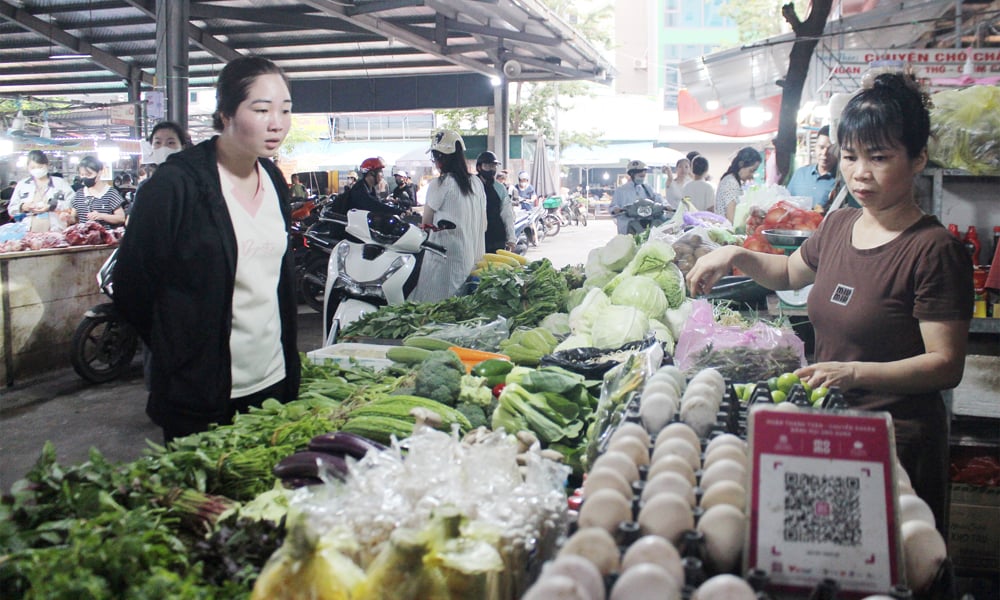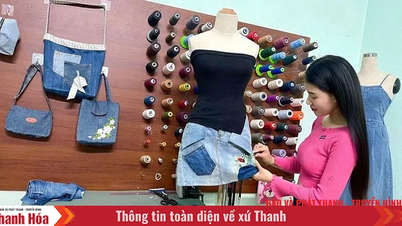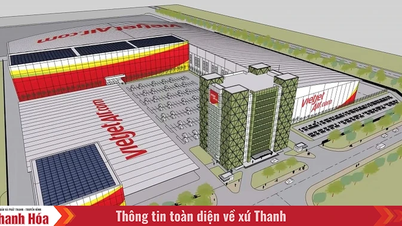Flexibility to retain customers
All vendors at the Central Market of Pho Moi Town (Que Vo Ward) have prepared QR Codes for customers to conveniently pay without cash when purchasing goods, even if it is just a bunch of vegetables, a fish or other expensive products. While selling to customers, Ms. Ha Thi Phuong, the owner of a vegetable and fruit kiosk, received a phone call and immediately grabbed a pen and quickly wrote it down in her notebook. She shared: "Nowadays, we do not only sell directly at the market, if customers are busy and cannot come to buy, they can call and I will deliver the goods to their homes. Nowadays, we have to diversify our sales methods, otherwise it is difficult to keep customers."
Vegetable and fruit selling area at Nam Son market, Nam Son ward. |
Along with direct sales at the counter, clothing retailer Le Hai Anh at Nam Son Market (Nam Son Ward) and many other shop owners have focused on building additional online sales channels on social networking platforms. Ms. Hai Anh said: "In recent years, customers coming to the market to buy goods have been decreasing, I have had to create Facebook and Zalo pages and join groups to advertise sales. Because I regularly update images of new products, good quality, reasonable prices... many customers have ordered by phone, helping to sell goods more regularly, even on rainy days".
Currently, the province has nearly 340 markets serving small traders and people who produce and sell products directly. Most small traders in traditional markets have proactively changed their business methods to suit modern trends. |
Not only in cities and urban areas, small traders in rural and mountainous markets are also gradually changing their business activities. An Chau Market, Son Dong Commune has more than 200 kiosks. Most of the kiosk owners have bank accounts or QR codes to meet customers' online payment needs. In addition, some small traders also provide home delivery services; regularly update new products to meet consumer tastes. Ms. Vu Thi Tam, Son Dong commune, is choosing to buy goods at An Chau market and said: “In the past, when shopping at the market, we only used cash to pay, which was sometimes quite inconvenient. In particular, the habit of haggling made me and many customers afraid to buy because we did not know how to bargain appropriately. Now, from selling vegetables to clothes, shoes, household appliances, etc., kiosk owners all have bank accounts or QR codes to make payment more convenient; prices are clearly listed. In addition, most of the vendors provide shopping services according to customers' needs, and behave civilly and politely.”
The Market Management Board has made efforts to rearrange the stalls into separate areas such as: Clothing, fruit, fresh meat areas, etc.; organize waste collection, clean up the aisles in the market. Thanks to that, the market still attracts a large number of people to visit and shop, contributing to promoting business activities.
Change for sustainable development
Currently, the province has nearly 340 markets serving small traders, people who produce and sell products directly. According to the leaders of the Department of Industry and Trade, most small traders in traditional markets have proactively changed their business methods to suit modern trends. In particular, young traders develop their business by selling goods through e-commerce platforms, social networks; applying management and payment settlement via technology software... Along with that, the Management Board and management teams of the markets have done a good job of monitoring buying and selling activities, ensuring order, traffic safety, and public security. Localities and functional agencies organize training, propaganda, and mobilize small traders to innovate their thinking, apply new business methods; sell products with clear origin and source... Thanks to that, business activities in the markets are still maintained stably. Thereby improving competitiveness and gradually affirming their position in the retail market.
However, traditional markets still face barriers due to the reluctance to change and limited understanding of technology of some traders, especially the elderly. In addition, a segment of consumers still have the habit of paying in cash. In addition, the technological infrastructure in many markets is not synchronized, the Wifi system, and phone charging points are not enough to affect the use of technological devices... These barriers slow down the digital transformation process. Without synchronous and drastic solutions, traditional markets will increasingly fall behind, losing their position in the modern commercial picture.
Mr. La Van Nam, Deputy Director of the Department of Industry and Trade, said: “In the coming time, the Department of Industry and Trade will continue to promote awareness and promote cashless payments in the community; promote the use of electronic payment methods in purchasing and consumption; support and introduce solutions for developing e-commerce, information technology and digital transformation applications... for small traders in the markets. At the same time, encourage small traders to apply digital technology in product promotion, sales, payment, management... This is an inevitable direction for traditional markets to develop sustainably in the modern retail environment.”
Article and photos: Thanh Ngan
Source: https://baobacninhtv.vn/cho-truyen-thong-bat-nhip-xu-huong-tieu-dung-hien-dai-postid424755.bbg




![[Photo] General Secretary To Lam attends the opening ceremony of the National Achievements Exhibition](https://vphoto.vietnam.vn/thumb/1200x675/vietnam/resource/IMAGE/2025/8/28/d371751d37634474bb3d91c6f701be7f)
![[Photo] Politburo works with the Standing Committee of Cao Bang Provincial Party Committee and Hue City Party Committee](https://vphoto.vietnam.vn/thumb/1200x675/vietnam/resource/IMAGE/2025/8/28/fee8a847b1ff45188749eb0299c512b2)

![[Photo] Red flag with yellow star flutters in France on National Day September 2](https://vphoto.vietnam.vn/thumb/1200x675/vietnam/resource/IMAGE/2025/8/28/f6fc12215220488bb859230b86b9cc12)
![[Photo] General Secretary To Lam presents the 45-year Party membership badge to comrade Phan Dinh Trac](https://vphoto.vietnam.vn/thumb/1200x675/vietnam/resource/IMAGE/2025/8/28/e2f08c400e504e38ac694bc6142ac331)
![[Photo] Prime Minister Pham Minh Chinh meets with Speaker of the New Zealand Parliament Gerry Brownlee](https://vphoto.vietnam.vn/thumb/1200x675/vietnam/resource/IMAGE/2025/8/28/cec2630220ec49efbb04030e664995db)































































































Comment (0)